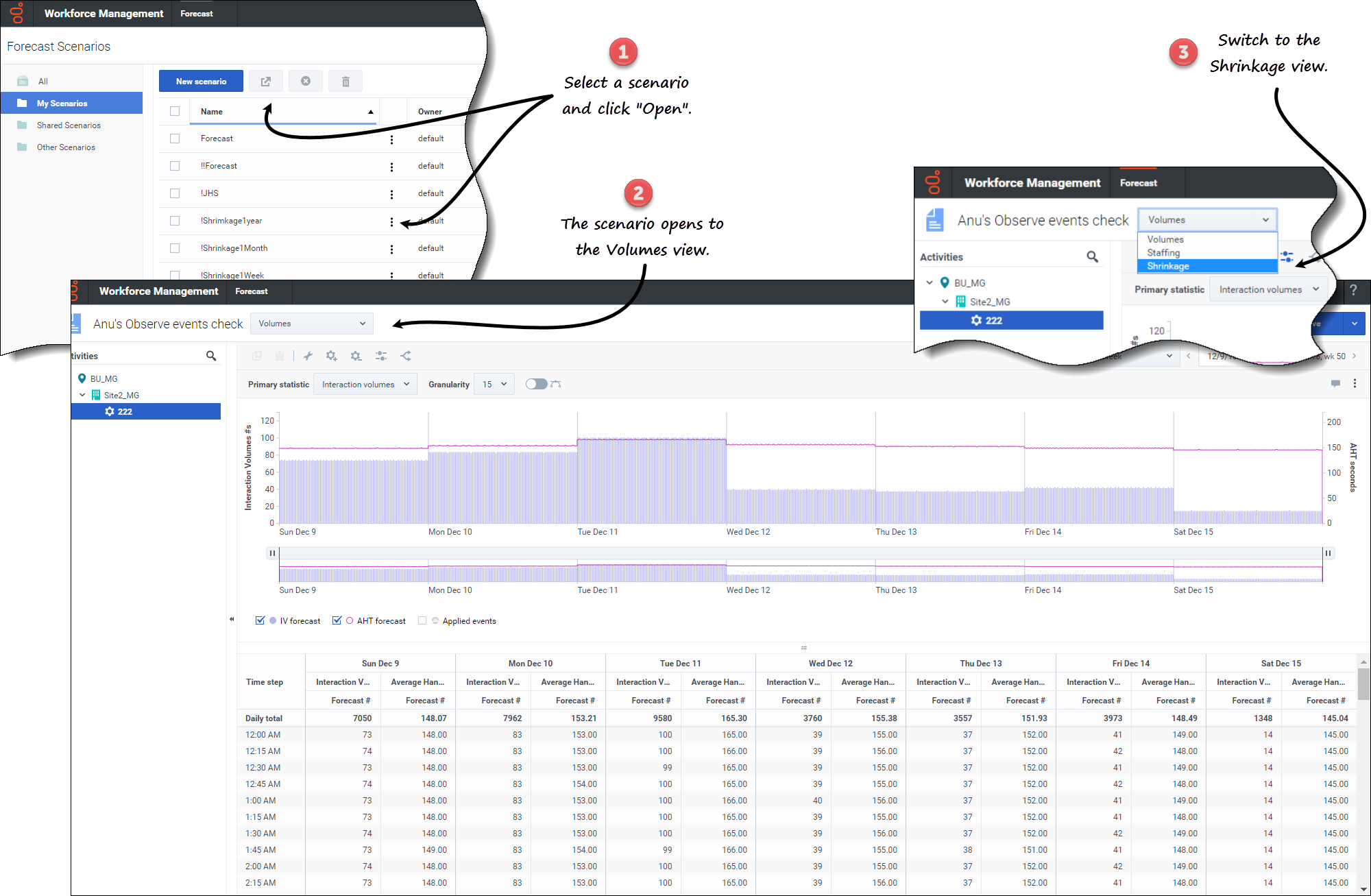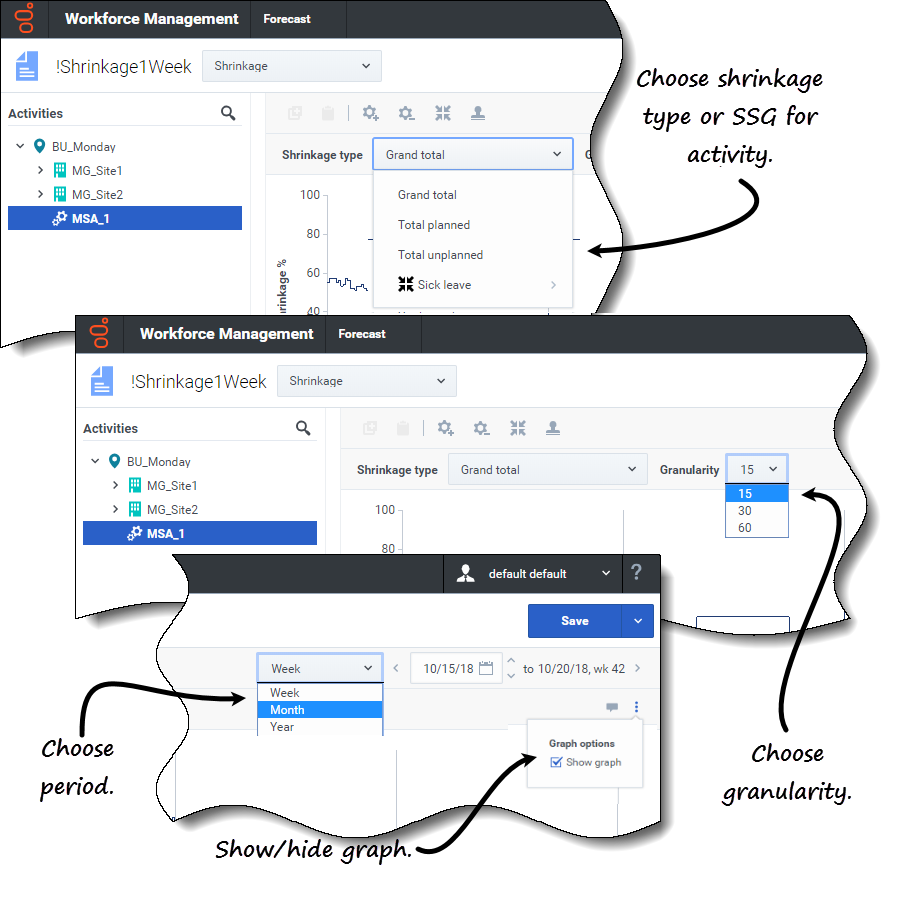Contents
Shrinkage in scenarios
In Workforce Management (WFM) you'll use the Shrinkage view (formerly named Overheads) to view overhead data, which WFM uses to forecast shrinkage while scheduling.
This view provides standard date-selectors and a grid that shows shrinkage percentages for days and timesteps.
You can perform the following functions in this view:
- View shrinkage totals
- Add and delete shrinkage associated with the current Schedule State Group for a specific activity
- Edit shrinkage associated with the current Schedule State Group for a specific activity
Viewing the shrinkage data
Open the Shrinkage view by using the scenario's drop-down menu (see below). Scenarios open to the Volumes view by default.
To open the Shrinkage view:
- In the Forecast module, select Scenarios.
- Select a scenario from the list in the data pane, and click Open in the toolbar or in the Actions
 drop-down menu.
drop-down menu.
- The Volumes view opens by default with the scenario name in the top-left corner of the window.
- Click the scenario's drop-down menu and select Shrinkage.
- In the Objects tree, expand a business unit, then a site to select an activity, or multi-site activity.
- The view displays a graph above a table or grid, each containing the same shrinkage values, and controls that set the data display properties for the graph and table.
If you have not selected an activity, you'll see the message Select an activity within the nested tree to load shrinage. If you still do not see any data, you might need to adjust the Period, Granularity, or date-selectors at the top of the window to reflect those used for the forecast.
You can also view, add, and edit the volumes or staffing data in opened scenarios, by selecting Volumes or Staffing from the drop-down menu near the scenario name.
Setting the data display properties
In this view, the graph's y-axis represents the shrinkage percentage; the x-axis represents the selected period (week, month, year). Use the following controls to customize the data display in the graph and table:
- Shrinkage type drop-down list—Select the shrinkage type that will be displayed as primary, by selecting Grand total, Total planned, or Total unplanned.
- If you select a business unit or site, you see only the first three shrinkage types. If you select an activity that is associated with a Schedule State Group (SSG), the SSG appears in the list. If you select a multi-site activity that has a child activity that is associated with a SSG, Schedule State Group<activity name> appears in the list.
- Period drop-down list—Change the period or time range for the graph and grid by selecting Year, Month, or Week.
- Granularity drop-down list—Adjust the granularity to Day if you selected Month or Year in the Period drop-down list. Adjust the granularity to 15, 30, or 60 (minutes) if you selected Select Week in the Period drop-down list.
- Date range—Use the date-selectors (top-right portion of the view) to switch to a different period within the scenario forecast's date range.
 Actions drop-down menu—Click this icon to change the graph:
Actions drop-down menu—Click this icon to change the graph:
- Graph options—Show/hide the graph and zoom bar by selecting/clearing the Show graph check box. See also Sliders.
Watch the video demonstrating how the following features work. (The smooth graph feature described in the first half of the video is not available this view.)
- Sliders—Drag the vertical slider left/right to show/hide the graph, zoom bar, grid and/or Objects pane. Click the arrows in the vertical slider to resize the Objects pane. Drag the horizontal slider up/down to show/hide the graph and/or grid.
- Zoom bar—Use the zoom bar handles to narrow or widen the focus in the graph, by sliding the handle left or right. You can zoom to a minimum of one day. After narrowing the focus, place your cursor over the graph and change the range of the zoom by dragging and dropping it to the left or right. For example, if you narrow the focus to Sunday, Monday, and Tuesday, but want to change it, drag and drop the zoom to the right to Tuesday, Wednesday, Thursday.
Reading the data
The table provides columns that display the following statistics:
- Daily total—If you select the period Week, this row shows daily totals for shrinkage.
- Weekly total—If you select the period Month or Year, these columns show the weekly totals for shrinkage.
- Date/Time step—Identifies the range of dates or timesteps in this row. The column name and contents will differ, depending on the period and granularity you selected above.
- [Days or Dates]—If you select the:
- Week date range—Each group of columns indicates one day. The top row shows daily totals and each lower row shows statistics for one timestep on that date.
- Month date range—Each group of columns shows shrinkage for one full day.
- Year date range—Each group of columns shows shrinkage for one full day.
- Timestep durations depend on the granularity that you selected above.
- Shrinkage type—If you select:
- Grand Total—A read-only statistic; the aggregate shrinkage for the selected target.
- Total Planned—A read-only statistic; the aggregate planned shrinkage for the selected target.
- Total Unplanned—A read-only statistic; the aggregate unplanned shrinkage for the selected target.
- <name>—The name of the Schedule State Group (SSG) when an activity is selected (for example My Meeting). Indicates shrinkage values that are associated with this SSG and the target. If the target is a multi-site activity, the activity name is prefixed with the SSG name (for example Schedule State Group<activity name>).
WFM displays shrinkage for the item that is selected in the Object pane. If the item is an activity, then the Shrinkage type list shows the Schedule State Groups that are associated with the activity. If the item is a multi-site activity, the menu lists all Schedule State Groups that are associated with its child activities.
You can edit shrinkage values for activities or multi-site activities. See Editing data in the grid.
Editing data in the grid
WFM enables you to edit forecast shrinkage data in the Scenario > Shrinkage grid:
- Enable editing in the grid by selecting an activity.
- Edit a multi-site activity by selecting and editing one of its child activities. (You cannot edit a multi-site activity directly.)
- Edit time steps and daily totals by selecting the period Week
- Edit weekly and daily totals by select the period Month or Year.
If you select Grand total, Total planned, or Total unplanned, editing values in the grid is disabled.
When changing the period, granularity, and/or values in the grid, note that daily totals are aggregated values for a 24-hour period. This means the daily and weekly totals automatically adjust and are redistributed according to the original distribution of shrinkage for each day of the week or week of the month/year. This is useful if you have a week in which you believe the shrinkage will increase, but you expect the shrinkage to arrive at about the same rate as in your original forecast, day-over-day.
Editing modes
WFM provides two editing modes in the Shrinkage grid. Single-clicking a cell puts it into quick-editing mode and double-clicking a cell puts it into deep-editing mode. You can use either method for all editing functions.
Entering invalid values
The Shrinkage grid does not accept invalid values. In most cases, WFM attempts to convert certain characters or symbols into a valid value. Here are some examples:
- If you enter a value similar to 1.$#!5, WFM converts it to 1.50%.
- If you enter a value a negative percentage, such as -88%, WFM converts it to 88%.
- If you enter a value greater than 99.99%, such as 899%, WFM converts it to 89%.
- If you enter a value with more than two digits after the decimal point, such as 40.009812%, WFM converts it to 40.00%.
In the grid, you can move from cell to cell by using the Enter or Shift+Enter keys on the keyboard. Click a cell and press:
- the Enter key to move the focus to the cell below the one selected.
- the Shift+Enter keys to move the focus to the cell above the one selected.
If you select a cell in the Daily total row, you can use Enter to move down one cell, but you cannot use Shift+Enter to move up one cell.
To edit the shrinkage data in the grid:
- Double click the cell you want to change and enter a value.
- When you have finished, in the upper-right corner of the view, click Save (or use the hotkey combo Alt+S).
- A message appears in the lower-right corner, indicating your changes were saved successfully.
If you switch to another view without saving the changes, a dialog opens with the message Would you like to save changes to <scenario name>. Click:
- Save to save the changes and switch to another view.
- Discard to discard the changes and switch to another view.
- Cancel to cancel the action, close the dialog, and return to the Shrinkage view.
From the Save menu, you can also select:
- Publish (Alt+P) if you have modified the scenario data and want republish it.
- Save as template... to save this scenario as a template.
- Close (Alt+W) to close the scenario.
Selecting data to copy and paste
WFM enables you to copy and paste data to/from the shrinkage grid. Selecting data in the grid enables the Copy button. After copying, a message appears indicating that data was copied to the clipboard. Selecting other cells in the grid enables the Paste button.
To copy and paste data in the grid:
- Open a scenario and select the Shrinkage view.
- In the Objects pane, expand the list to select an activity or multi-site activity.
- If you select a multi-site activity, Paste is disabled. You can only paste activities.
- In the grid, select the cells that you want to copy.
- In the toolbar, click Copy
 .
. - In the grid, select the cells into which you want to paste.
- In the toolbar, click Paste
 .
. - In the upper-right corner of the view, click Save.
When copying/pasting values in the Shrinkage view:
- You must copy/paste the Daily totals/Average row separately. It cannot be copied or pasted with other rows.
- Attempting to paste some letters, symbols, negative values, or values greater than 99.99 into the grid generates the message Cannot paste invalid values.
- You can copy/paste within the grid or to an external source, such as Excel or NotePad.
- Paste is disabled when:
- The selected object is a business unit or site.
- The Shrinkage type selected is Grand total, Total Planned, or Total Unplanned.
- The selected cells for weekdays are outside the scenario weekdays.
You can also use the Ctrl-C and Ctrl-V key combinations on your keyboard to select data in the Shrinkage view grid for copying and pasting.
Using the Scenarios Shrinkage toolbar
![]()
Use the following buttons on the toolbar (above the graph) to modify and manage shrinkage data:
| Icon | Name | Description |
|---|---|---|
| Copy | Copies data selected in the grid to the clipboard. | |
| Paste | Pastes data from the clipboard to the selected area in the grid. | |
| Add activities | Opens the Add Activities dialog, enabling you to add activities to scenarios. | |
| Remove activities | Opens the Remove Activities dialog, enabling you to remove activities from scenarios. | |
| Add shrinkage | Opens the Add Shrinkage dialog, enabling you add shrinkage to Schedule State Groups that are associated with activities or multi-site activities. | |
| Apply template | Opens the Apply Template dialog, enabling you to add shrinkage to Schedule State Groups by applying a template. |





